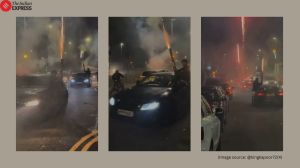Thumbs up for Manmohan at the wheel but most think Sonia doing backseat driving, prefer her as PM
The aam admi seems to have given Prime Minister Manmohan Singh just the mix of good and bad news he may have hoped for on the eve of a difficult parliamentary session. Ordinary citizens think of their prime minister as an honest...

• Thumbs down on Govt’s handling of farmers’ suicides, price rise and terrorism
• Pretenders can dream on: only a fifth want someone outside Gandhi family to replace PM
The aam admi seems to have given Prime Minister Manmohan Singh just the mix of good and bad news he may have hoped for on the eve of a difficult parliamentary session. Ordinary citizens think of their prime minister as an honest, wise and trustworthy person, though they are not sure of his being a strong leader. They are, on balance, satisfied with his work but this has not made him into a charismatic leader whose popularity may threaten the first family in Indian politics.
The PM may have desperately hoped for this piece of bad news as much as some appreciation of his work. But there is one piece of bad news that he may not have wanted. The aam admi is unhappy about how the PM has handled price rise, farmer’s suicides and terrorism.
These conclusions are based on the first nationwide survey focussed on the performance of Manmohan Singh after taking the office more than two years ago. Conducted by the Centre for the Study of Developing Societies (CSDS), The Indian Express-CNN-IBN survey, broadcast on CNN-IBN tonight, is perhaps the first one of its kind focussing exclusively on a range of questions dealing with the evaluation of a prime minister. The poll will be re-broadcast tomorrow at noon.
A total of 1,884 respondents were interviewed at their residence between July 16 and July 19. The conclusions based on this relatively small survey are broadly reliable since the interviews were not concentrated in some towns or only a few states but were spread across 18 states. The profile of the respondents interviewed matches the national profile very closely (see methodology box inside).
Let us first look at the good news for the PM.
The intense media speculation about the “PM in siege” and political intrigue about the possibility of a change of guard does not seem to have affected the charity that the Indians have usually extended to their top leaders.
On balance, the ordinary people are quite satisfied with the work does by the PM: 56% satisfied versus only 18% dissatisfied means a ratio of about 3:1 of satisfied to dissatisfied. The ratio goes up to 6:1 among the UPA and also Left voters and drops to about 2:1 among those who had voted for the NDA in 2004.
That is not a bad rating, coming from the rival camp. The country’s first PM from a minority community is understandably a shade more popularly among the minorities but is acceptable across the entire social spectrum.
When asked to give the PM marks out of 100 on his work so far, the respondents gave him 68 marks, a little higher than the famous six-out-of-ten that the PM gave himself on the completion of his one year in the office.
The Congress and the Left voters would like to award him a “distinction” while the BJP voters would give him a high second class.
In terms of specific attributes, the PM’s biggest asset continues to be his image of being an honest leader. As many as 64% of the respondents agree that he is honest against only 8% who disagree. This ratio of 8:1 is replicated across the political divide; even the BJP voters concede this.
His intelligence and wisdom is another very strong point that gets him support across the spectrum. He is respected a little more for this among the educated respondents than among the less educated. All in all, people find him trustworthy, a crucial asset for any political leader.
Compared to the poll held in January, his trust rating has dropped by about 5 points. But when he is compared to other recent Prime Ministers, his overall evaluation is quite positive. He is rated to have been better PM for the country than all the recent PMs except Atal Bihari Vajpayee.
This positive evaluation comes with the right kind of “bad news.” The PM is not seen as a strong leader with an independent mind. Only 8% believe that he takes major policy decisions on his own as against 46% who think that Sonia takes all or at least all the major decisions.
The PM is nowhere close to becoming a larger-than-life figure or a charismatic leader like Vajpayee who was more popular than his party. In the popularity ranking for the most preferred choice as the Prime Minister, Singh is still placed third.
At 16% of the popular support, he is no threat to Sonia Gandhi who leads with 29%, having overtaken Vajpayee shortly after the 2004 elections. The PM has added 5 points to his popularity since January, reflecting higher name recognition over time, but not at the expense of Sonia Gandhi.
The BJP has reasons to feel threatened for Vajpayee’s popularity is falling steadily since the last Lok Sabha elections without any corresponding gains for Advani or any other leader from the party.
Sonia Gandhi’s stature as the most respected political leader appears quite secure. Given a choice, a clear majority of the respondents and two thirds of the Congress voters would like to see Sonia Gandhi herself rather than Manmohan Singh as the prime minister.
Only the BJP and the Left voters contest this proposition. The Congress voters would, on balance, settle for Rahul Gandhi as well in preference to Singh. But this sentiment does not prevail outside the Congress voters. Among the Congress voters who have an opinion, nearly 90% would prefer someone from the Gandhi family to Singh or anyone else.
If the Gandhi family is excluded from consideration, 40% respondents would like Sigh to continue as against only 22% who would like him to be replaced by someone else within the party. In this respect, the Congress voters were no different than the rest; voters of Congress allies were more loyal to Singh than the Congressmen.
When those wanting a change were asked to name the alternative, no Congress leader could secure even 2% of popular support. Most of the pro-changers favoured “any one from Congress.” In other words, while people prefer Manmohan Singh, Sonia Gandhi continues to enjoy a free hand in this matter.
The respondents don’t mind her role in the decision-making of the government. No one except BJP voters, not even those who voted for the BJP allies, have any problem in the PM taking instructions from Sonia Gandhi.
The media and the analysts may have problems with this unusual division of political and governmental power, but the ordinary people are not bothered by these subtleties.
Similarly, voters do not think that the PM has allowed himself to be unduly pressured by the Left parties; more voters see this as a legitimate consultation with an ally rather than blackmail tactics.
But there is one real piece of bad news for the PM in the survey. When the respondents were quizzed about the PM’s handling of some specific issues, he came up for serious criticism. No, it is not his mysterious silence on reservations that the people are unhappy about. On balance, his approach on reservation is approved by the people. His government’s handling of terrorism is not approved. It should be noted that the survey took place within a few days of the Mumbai blasts and may have been affected by it. The anxiety on this score was more pronounced in states like Maharashtra, Gujarat, Uttar Pradesh and Delhi that have witnessed terrorist incidents.
Ironically, the most serious indictment of the economist prime minister comes on his handling of the economy. The survey shows a strong disapproval of his handling of the farmers’ suicides, which can be seen as an unease with the agrarian policy. The most severe indictment comes on “price rise.”
As many as 56% of the respondents hold his policies in this regard to be a failure, compared to only 17% who think he has been a success. The politician in Singh knows that when the aam admi talks of “price rise” he is not talking about what the economists call “inflation” which is low in India by international standards.
This is another way of talking about lack of purchasing power, about poverty. In other words, his government is being seen as a failure in addressing poverty. Note that the same respondents who see him as honest and wise are not willing to call him pro-poor. Manmohan Singh obviously knows the political cost of being seen as pro-rich. If not, he could always consult his predecessor in this office.
106 locations across India: how poll was done
• Findings presented here are based on the survey conducted by Centre for the Study of Developing Societies (CSDS) at 106 locations spread across 53 assembly constituencies in 18 states of India. The assembly constituencies and polling stations were selected randomly using PPS method. The respondents were selected randomly from the voters list. Substitution of sampled respondents was allowed in special cases. Six of the sampled assembly constituencies had to be replaced in UP and West Bengal due to monsoon conditions.
The fieldwork for the survey was conducted between July 16-19. A total number of 3180 respondents selected from the electoral rolls were approached for the survey of which 1884 could be successfully interviewed. While the profile of the respondents matches the profile of the population of states where survey was conducted, substitution of constituencies led to a slight over-representation of the urban population. This has been corrected in the analysis presented here by using weights. The survey was directed by Sanjay Kumar of the CSDS and the data analysed by Himanshu Bhattacharya, Kanchan Malhotra, K A Q A Hilal and Praveen Rai. — ENS





- 01
- 02
- 03
- 04
- 05


























